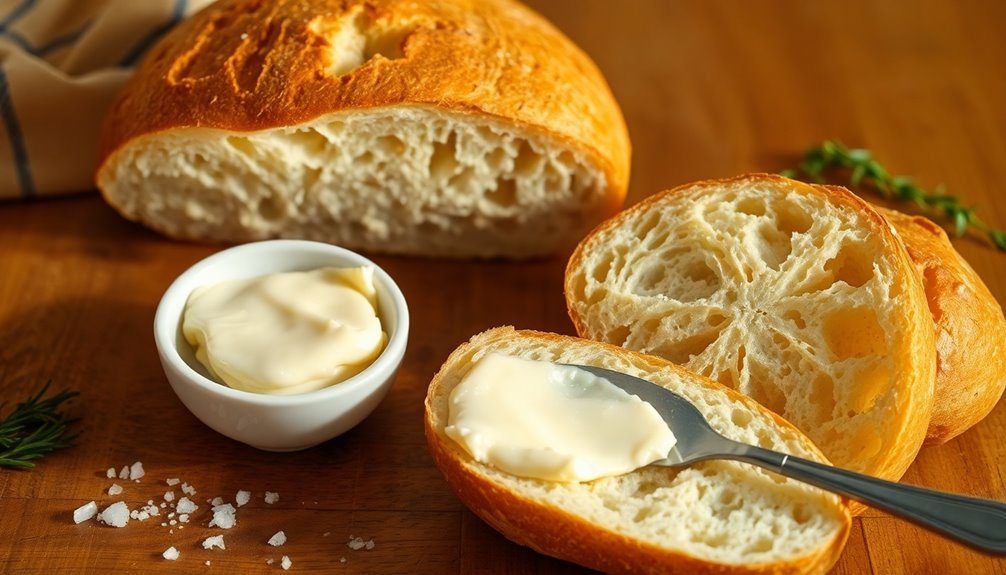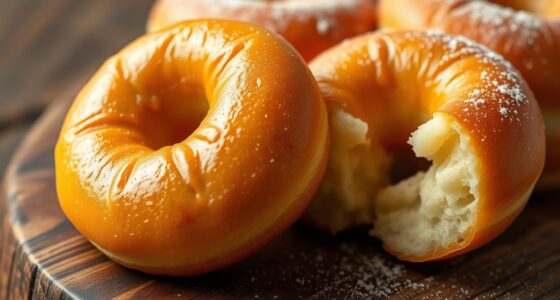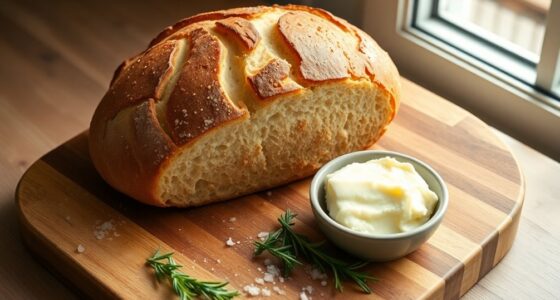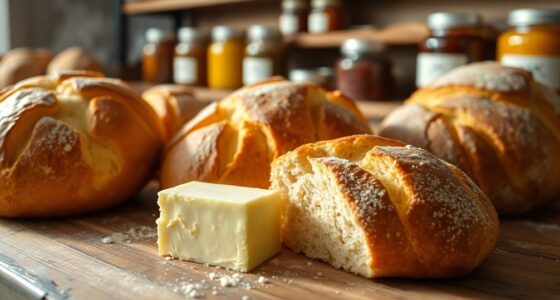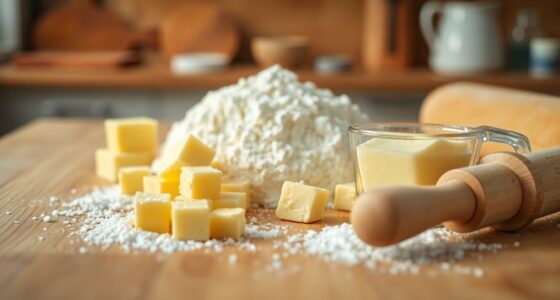Classic breads have been cherished for centuries, and they truly shine when you add butter. Think of a warm, crusty loaf of sourdough or a sweet, fluffy brioche—both transform into a blissful indulgence with a smear of rich butter. Rustic baguettes, hearty whole grain loaves, and classic Italian focaccia also become more delightful with this creamy complement. Explore these five timeless recipes and discover how to elevate your bread experience with butter's savory touch.
Key Takeaways
- Homemade classic bread recipes, such as white and whole wheat, are enhanced by the rich flavor of butter spread on warm slices.
- Sourdough bread pairs beautifully with butter, adding a creamy texture that complements its tangy taste.
- Brioche, known for its buttery richness, becomes even more indulgent when topped with additional melted butter.
- Garlic bread, made from classic loaves, transforms into a savory delight with butter infused with herbs and garlic.
- Sweet breads, like cinnamon rolls, are elevated by a drizzle of buttery icing, enhancing their sweetness and moisture.
History
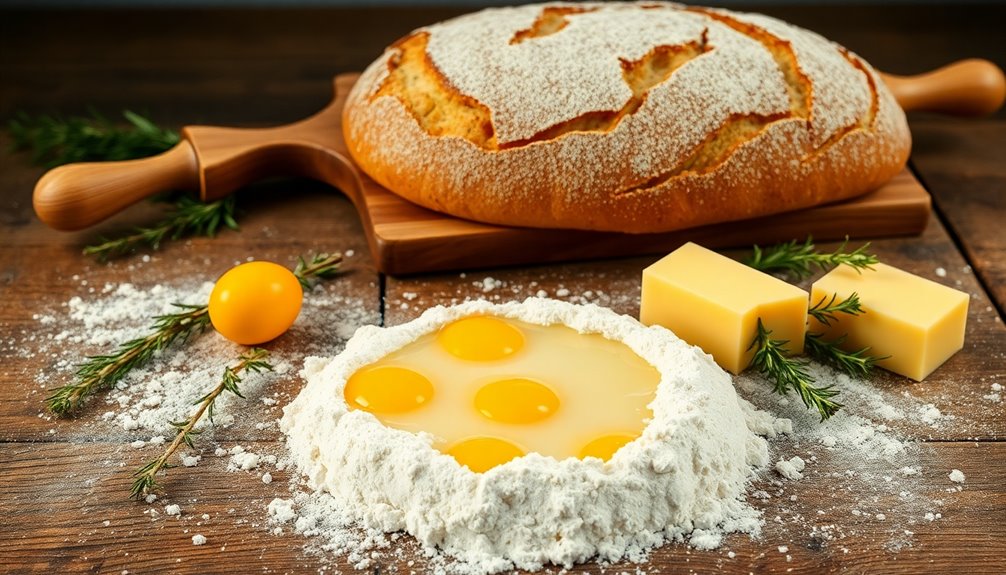
Bread has been a fundamental part of human civilization for over 14,000 years, and it's fascinating how its journey reflects our own development.
You mightn't realize that ancient Egyptians perfected bread-making around 3000 BC, using yeast to create lighter, fluffier loaves.
During medieval times, bread became a staple, with white bread recipes favored by the wealthy while the poorer classes consumed coarser varieties.
The Industrial Revolution transformed this history, making bread production more efficient and leading to the invention of sliced bread.
Today, homemade bread, whether it's a classic white bread recipe or a rustic loaf, is often enjoyed with butter, creating a delicious bread experience that connects you to centuries of culinary tradition. Butter is a source of vitamins that enhance the nutritional value of this timeless staple.
Recipe
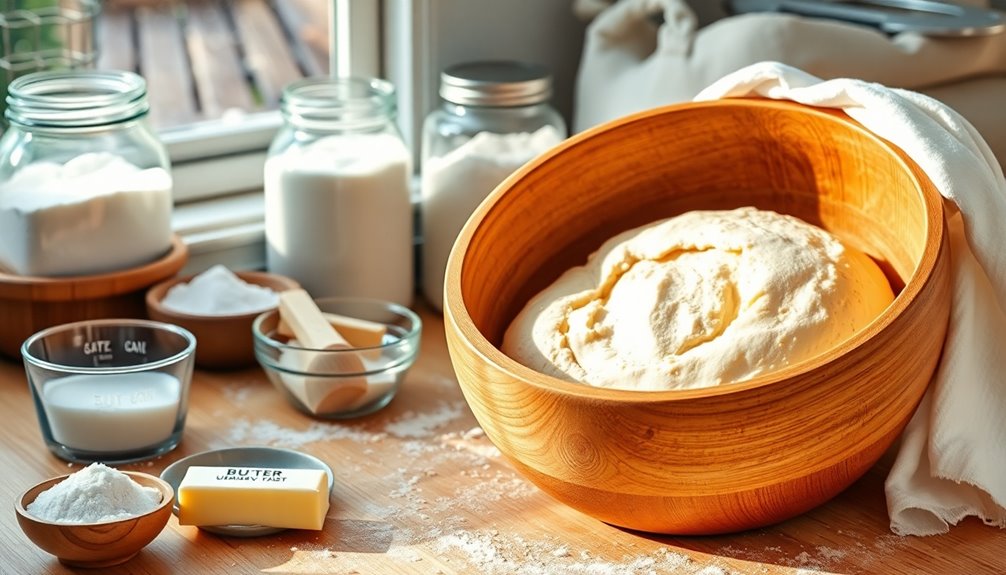
Ingredients:
- 4 cups all-purpose flour
- 1 packet (2 ¼ teaspoons) active dry yeast
- 1 ½ cups warm water (110°F to 115°F)
- 2 tablespoons sugar
- 2 teaspoons salt
- 2 tablespoons unsalted butter, melted (optional)
Instructions:
In a large mixing bowl, combine the warm water, sugar, and yeast, allowing it to sit for about 5 minutes until frothy.
Next, add the salt and melted butter (if using), followed by the flour, one cup at a time. Mix until a sticky dough forms.
Knead the dough on a floured surface for about 8-10 minutes until it becomes smooth and elastic.
Place the dough in a greased bowl, cover it with a clean cloth, and let it rise in a warm area for about 1 to 2 hours, or until it doubles in size.
Once risen, punch down the dough, shape it into a loaf, and place it in a greased 9×5-inch loaf pan.
Cover it again and let it rise for another 30-45 minutes.
Preheat your oven to 350°F and bake the bread for 30-35 minutes, or until the top is golden brown and sounds hollow when tapped.
Allow it to cool before slicing.
Extra Tips:
For the best results, make sure your water is the right temperature to activate the yeast effectively.
If you want to add a little flavor, consider mixing in herbs or garlic powder with the flour.
Additionally, brushing the top of the bread with melted butter right after removing it from the oven will give it a beautiful sheen and extra richness.
Always store your bread in an airtight container to keep it fresh for as long as possible.
Enjoy your homemade classic white bread!
Cooking Steps
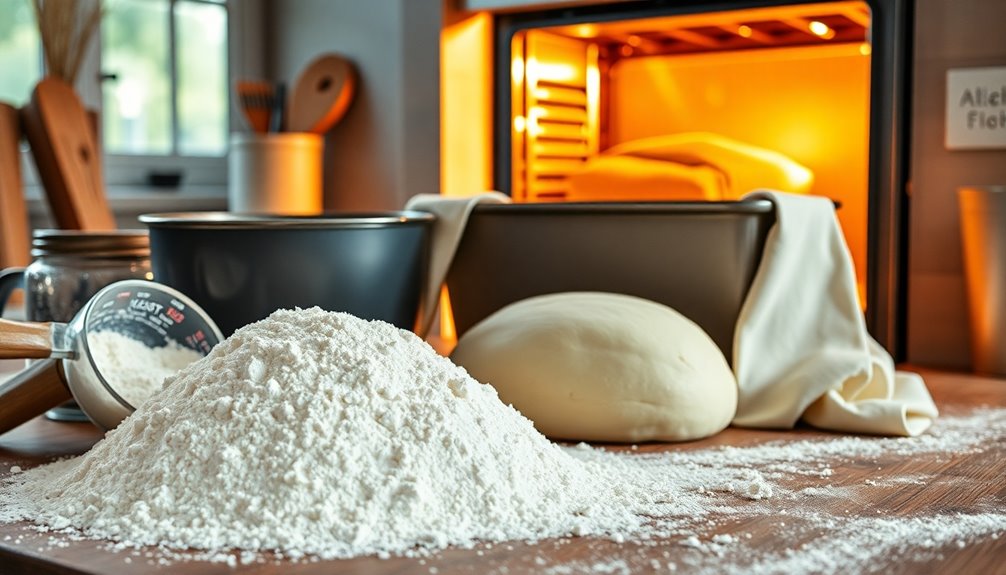
To make classic bread, start by gathering all your ingredients.
Next, mix the wet and dry components until they come together, then knead the dough until it's smooth.
After that, let it rise until it doubles in size, setting you up for a perfect loaf. Incorporating unsalted butter during the mixing process can enhance the flavor and texture of your bread.
Step 1. Gather All Ingredients First
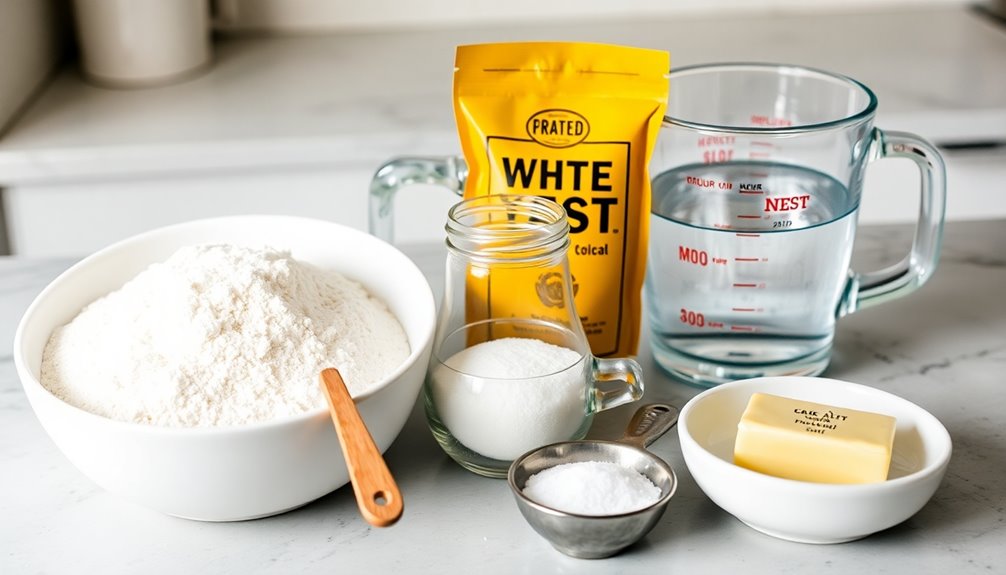
Before diving into your bread-making adventure, gather all your ingredients. This step is crucial for easy homemade bread recipes.
Start by checking for freshness, especially with yeast and flour, to ensure your quick breads rise beautifully. Measure ingredients accurately using standardized measuring cups and spoons; this helps maintain the right balance of flavors and textures.
Organize your workspace by placing ingredients in the order you'll use them, making it easier to follow the recipe smoothly. If your recipe requires it, don't forget to preheat your oven or bread machine to the specified temperature. Additionally, ensure your air purifier maintenance is up to date to keep your kitchen air clean while you bake.
Step 2. Mix Wet and Dry Ingredients
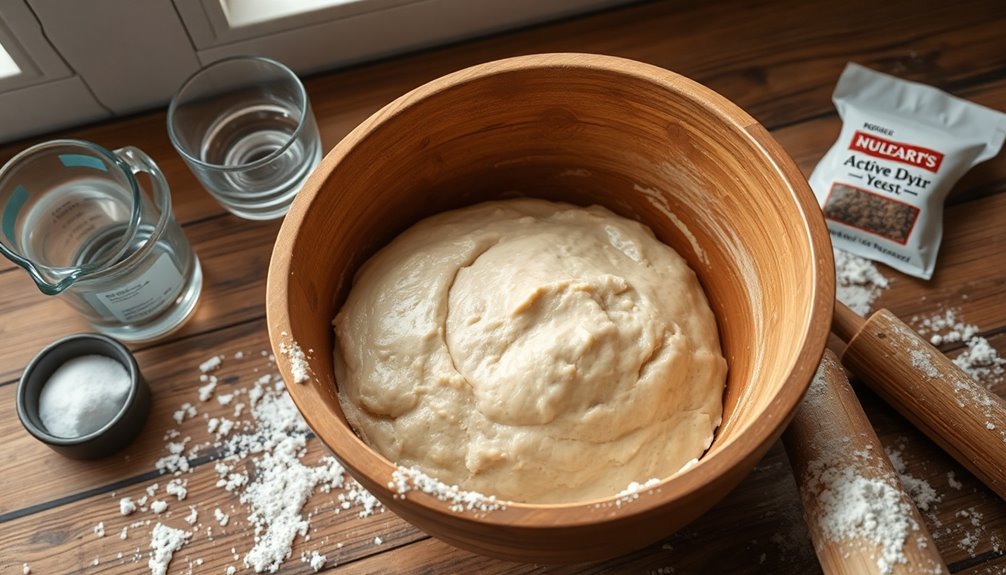
With your ingredients organized and ready, it's time to mix the wet and dry components.
Start by measuring your dry ingredients—like flour, sugar, and baking powder—ensuring even distribution. For the wet ingredients, use room temperature items like milk, eggs, and melted butter.
Create a well in your dry mixture and pour in the wet ingredients to help incorporate them easily. It's important to mix gently until just combined; overmixing can make your quick bread tough. If you're making sweet bread, this step is crucial for a tender texture.
After mixing, let the batter rest for a few minutes. This enhances moisture retention, making that golden brown crust even better! Additionally, remember that moderation is key when adding high-fat ingredients to your recipes to maintain a balanced diet.
Now, you're ready for the next step!
Step 3. Knead Dough Until Smooth
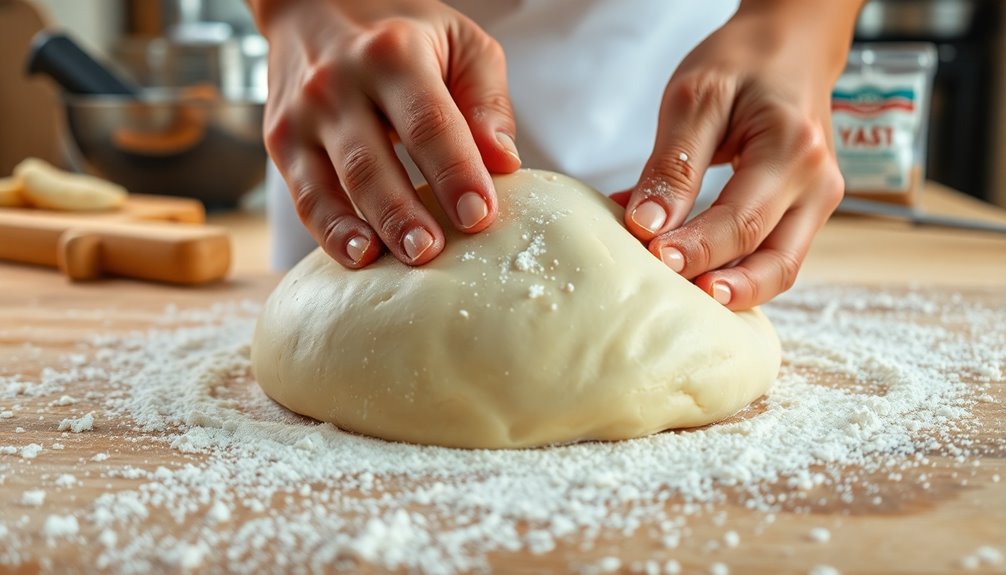
Knead the dough until it transforms into a smooth, elastic ball. This process is crucial for developing gluten, which gives your fresh bread its structure and chewy texture.
Spend about 8-10 minutes kneading by hand or 4-6 minutes in a stand mixer. If the dough feels sticky, lightly flour your hands and work surface, but avoid adding too much flour to keep it from becoming dry.
To check if you've properly kneaded the dough, perform the windowpane test—stretch a small piece; it should stretch thin without tearing. When you poke it, properly kneaded dough should spring back, indicating that the gluten is ready for fermentation. Additionally, consider setting specific savings goals for any baking-related expenses to help manage your budget effectively.
Now you're set to make a loaf that's deliciously satisfying!
Step 4. Let Dough Rise Until Doubled
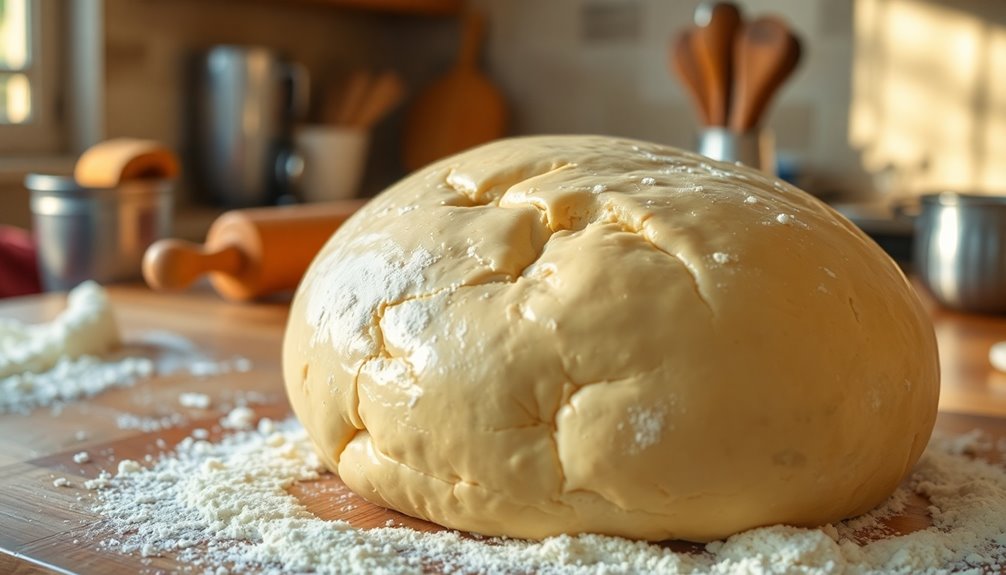
Once you've kneaded the dough to perfection, it's time to let it rise until it doubles in size.
Find a warm environment, ideally around 75-80°F, to encourage yeast activity. This temperature helps achieve a well-aerated texture in your bread.
Cover the dough with a clean kitchen towel or plastic wrap to prevent it from drying out and to keep humidity levels up. Allow the dough to rise until it has doubled in size, which can take 1 to 2 hours, depending on your recipe and ambient temperature.
To check if it's ready, gently press two fingers into the surface; if the indentation remains, you're good to go.
Step 5. Shape the Dough Into Loaves
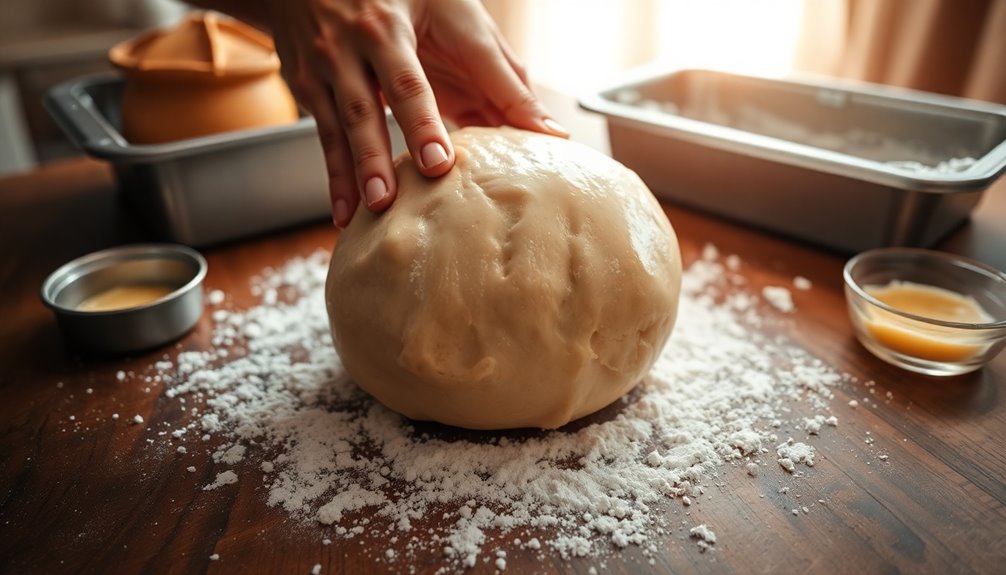
Shaping your dough into loaves is a crucial step in bread-making that sets the stage for a perfect rise and texture.
Start by ensuring your work surface is lightly floured to prevent sticking. Gently deflate the risen dough by pressing down, then divide it into portions for uniform loaf sizes.
For each piece, shape the dough by folding the edges toward the center and rolling tightly to create surface tension. This technique helps your loaf rise evenly.
Place the shaped loaves seam-side down in greased loaf pans to ensure a smooth top during baking.
Finally, cover the shaped loaves with a damp cloth and let them rise again until they've doubled in size, ready for the oven. Incorporating high fat content in your dough, such as with butter, enhances the flavor and richness of the bread.
Final Thoughts
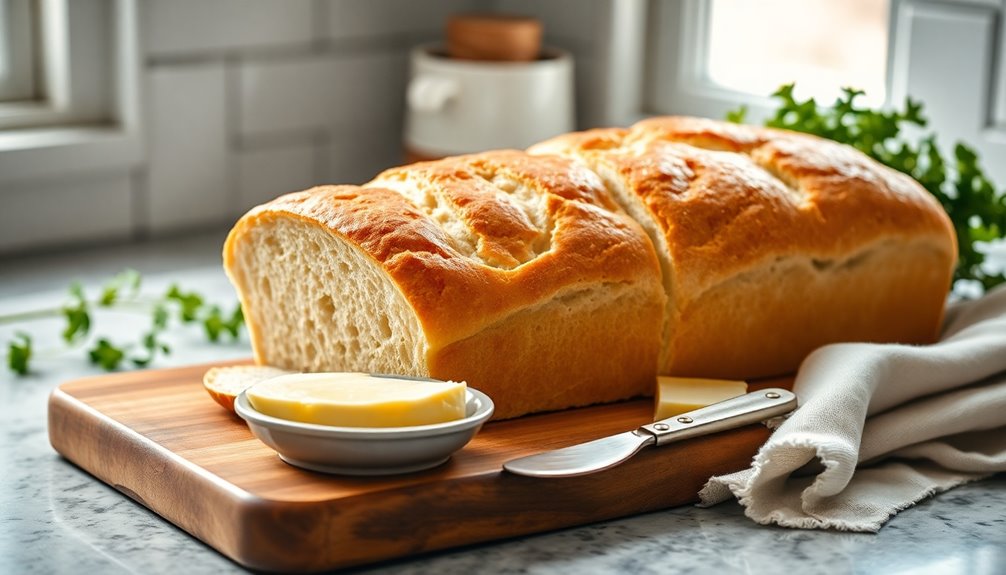
As you explore classic bread recipes, you'll discover that each loaf holds a unique charm and offers a delightful blend of flavors and textures.
Whether it's the buttery texture of brioche or the comforting treat of sourdough slathered with melted butter, each bite enhances flavors in a way that's simply irresistible.
Garlic herb bread becomes a savory side, while cornbread benefits from a pat of butter, adding moistness and rich flavors.
Challah's sweetness shines when paired with creaminess, perfect for special occasions.
These classic breads not only satisfy cravings but also elevate indulgent meals, making every gathering feel special.
Embrace these recipes, and enjoy the joy they bring to your table!
Frequently Asked Questions
What Does Adding Butter to Bread Do?
Adding butter to bread does a lot for your baking. It enhances flavor, giving your loaf a rich, creamy taste.
You'll notice a tender crumb as it coats the flour proteins, keeping gluten formation in check. Butter also adds moisture, helping your bread stay fresh longer.
When you incorporate it into the dough, it creates a flaky texture, especially in layered breads. Plus, it promotes a golden-brown crust, deepening overall flavor.
What Ingredients Make Bread Taste Better?
To make bread taste better, you'll want to consider a few key ingredients.
Adding honey or sugar can introduce a subtle sweetness, balancing savory notes. Incorporating herbs like rosemary or spices like garlic can elevate the flavor profile, while using bread flour instead of all-purpose flour creates a chewier texture.
For added complexity, mix in cheese or nuts, which provide umami and crunch, enhancing the overall taste experience.
What Are the 7 Common Bread Making Mistakes and How Do You Prevent Them?
Making bread can feel like a dance; one misstep, and you've got a flop. To avoid common mistakes, check your yeast's freshness, use lukewarm liquids, and knead just enough to develop gluten.
Keep salt away from the yeast, and don't rush the rising time. Remember, patience is key to achieving that airy texture.
What Are the 3 Main Quick Breads?
When you think of quick breads, three main types come to mind: banana bread, zucchini bread, and cornbread. Each one offers a unique flavor and texture, making them popular choices for quick baking.
Since you don't need yeast, these breads rise quickly, allowing you to enjoy them in no time. Plus, they're versatile; you can add fruits, vegetables, or nuts to enhance their taste and nutritional value even further.
Enjoy experimenting!
